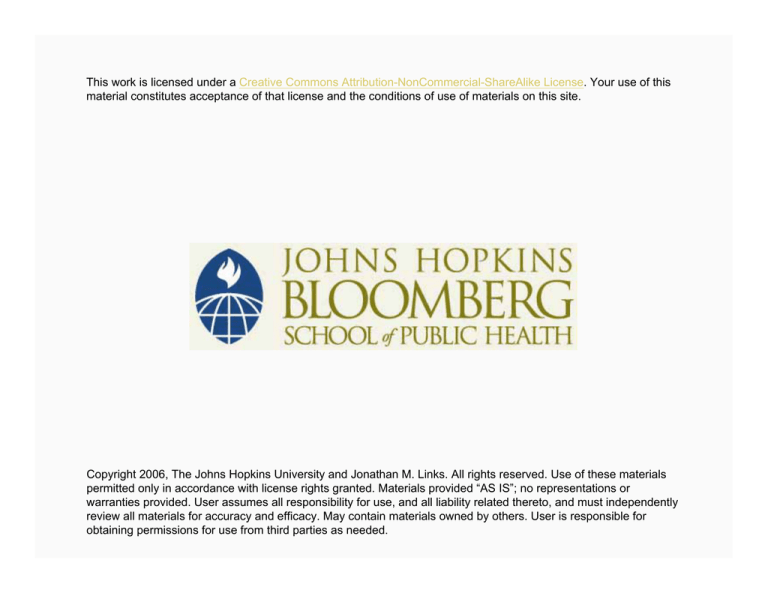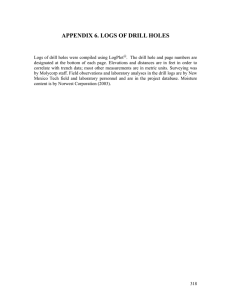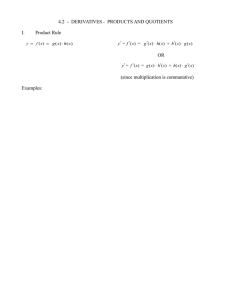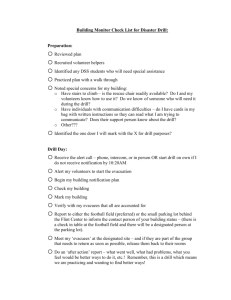
This work is licensed under a Creative Commons Attribution-NonCommercial-ShareAlike License. Your use of this
material constitutes acceptance of that license and the conditions of use of materials on this site.
Copyright 2006, The Johns Hopkins University and Jonathan M. Links. All rights reserved. Use of these materials
permitted only in accordance with license rights granted. Materials provided “AS IS”; no representations or
warranties provided. User assumes all responsibility for use, and all liability related thereto, and must independently
review all materials for accuracy and efficacy. May contain materials owned by others. User is responsible for
obtaining permissions for use from third parties as needed.
Terrorism Case Studies: Baltimore City
Jonathan M. Links, PhD
Johns Hopkins University
Overview
Three case studies will be presented:
1. Baltimore City Drill #1
2. Baltimore City Drill #2
3. (University of Maryland Medical System) UMMS Drill #1
Objectives
These case studies will illustrate:
− Plausible scenarios
− Typical first response activities
− Critical issues on-the-fly
− Considerations for planning
Baltimore City Drill #1
Section 1 of 2
Baltimore City Drill #1
June 6, 12 noon
Explosion at Inner Harbor
First responders
− Bomb squad (Police department)
− Hazmat (Fire department)
Detection of radiation (5 rem/hr)
What do you do?
Questions: Drill #1-1
Does any first responder “go in?”
If so, who?
Who gets notified?
What’s done in the meantime?
Answers: Drill #1-1
Bomb squad goes in to look for “secondary devices”
Bomb squad notifies (the rest of the) Police
Department; Hazmat notifies (the rest of the) Fire
Department
Baltimore City Health Department and Maryland
Department of the Environment are also notified
Where is the answer to last question?
Baltimore City Drill #1-2
Wind from E @ 10 mph
12-block radius evacuation begun
Emergency Departments (EDs) alerted (victims +
radioactivity)
What do you do?
Questions: Drill #1-2
How do you organize the evacuation?
To where do you direct the people?
What do you tell the EDs (and why)?
What should the EDs do?
Answers: Drill #1-2
The evacuation is performed from the inside out so
that it may be halted in progress
People are directed upwind to a designated site
Answers: Drill #1-2
The evacuation is performed from the inside out so
that it may be halted in progress
People are directed upwind to a designated site
The EDs must be alerted that radioactive victims will
appear, and triage and decon should commence
outside the ED
Baltimore City Drill #1-3
Wind changes, from SW 3-5 mph
What do you do?
Questions: Drill #1-3
How do you know the wind changed direction?
How does the change in wind direction influence your
thinking/planning?
Who do you notify?
Answers: Drill #1-3
Wind direction will influence the location of off-site
triage and decon (upwind!)
So, ongoing monitoring of wind direction is critical
Health, Fire, and Police Departments all need
notification
Baltimore City Drill #1-4
Off-site radiation readings at background levels
Off-site decon and triage set up
Questions: Drill #1-4
How do you know the radiation readings?
Where (and when) do you monitor?
How do they influence your decisions?
Where do you set up triage and decon?
Are they in the same place?
What do you need there?
Answers: Drill #1-4
On- and off-site radiation monitoring is critical
This monitoring is with a combination of detectors
Triage and decon can be done at the same (off-site)
location; monitoring must be done here, too
Representative First Responder Detectors
Baltimore City Drill #1-5
15 minutes later: shots are fired on first responders;
bomb squad leader killed
What do you do?
Questions: Drill #1-5
Does anything change?
If so, what?
Answers: Drill #1-5
First responders are pulled from the immediate scene
SWAT (QRT, Quick Response Team in Baltimore City)
goes in to clear buildings of snipers
Baltimore City Drill #1-6
QRT (SWAT) goes into buildings to clear of snipers (at
least two in two different buildings)
Two other suspicious packages identified; checked for
radiation (negative)
One sniper killed; one taken into custody
Questions: Drill #1-6
Is the QRT activity “in parallel” with the PH activity?
What do you think about?
Answers: Drill #1-6
The QRT activity supercedes public health activities,
which resume only after the “all clear”
The QRT must be monitored for radiation dose and
pulled if/when it gets too high
Baltimore City Drill #1-7
Victims evacuated to area hospitals
Mayor has series of press conferences
Questions: Drill #1-7
What are the next steps?
What are the long term plans?
Answers: Drill #1-7
The site is secured
Evidence is gathered (don’t forget it’s a crime scene!)
Environmental monitoring is enhanced
Long-term remediation planning begins
What Did We Learn?
Communication
− Who knew what?
− When did they know it?
− Who told them?
What was done correctly?
What could be improved?
Baltimore City Drill #2
Baltimore City Drill #2-1
Operation Down Under
Explosion in subway
Victims are vomiting and seizing
Smoke, fire, and explosive damage
What do you do?
Questions: Drill #2-1
Who arrives first, and what should they do?
To which questions do you need an immediate
answer?
What do (can) you assume?
Answers: Drill #2-1
Police and Fire Department personnel are on the
scene first
− Ideally, only those with appropriate personal
protective equipment (PPE) will enter the subway
… but this often is not the case
You can assume some sort of “agent” is involved
It is critical to identify both the agent and its
environmental distribution
T Notes Available
Baltimore City Drill #2-2
Rescue, fire-fighting, and decontamination begin
What do you do?
Questions: Drill #2-2
How do you protect the first responders?
Who do you “allow” to do what?
How do you treat the victims?
How do you decon the victims?
Answers: Drill #2-2
Only first responders with Personal Protective
Equipment (PPE) should go in and interact/rescue
victims
The victims should be triaged and decontaminated
away from the immediate site
Clothing should be removed, and the body (especially
head and hands) should be washed
Baltimore City Drill #2-3
Identification of agent (methylparathion)
What do you do?
Questions: Drill #2-3
How is the agent identified?
How do you get a sample?
How does the info help you?
Answers: Drill #2-3
The agent is identified from a sample:
− Environmental “wipe” sample
− Scrap of victim clothing
Chemical analyses are performed
The identity of the agent helps with triage, diagnosis,
prognosis, and treatment planning
Baltimore City Drill #2-4
Victims are evacuated to area hospitals
Mayor has series of press conferences
Questions: Drill #2-4
What are the next steps?
What are the long-term plans?
Answers: Drill #2-4
The site is secured
Evidence is gathered (don’t forget it’s a crime scene!)
Environmental monitoring is enhanced
Long-term remediation planning begins
Environmental Distribution: Baltimore City Drill #1
Dirty Bomb dispersed radioactivity in environment
− The magnitude, height, and wind will tell you how
far the agent will travel—as well as the risk to the
public
− Assume radioactivity stays airborne for a period of
time and will be dispersed by wind
Environmental Distribution: Baltimore City Drill #2
Explosion in subway
− Aerosolized a liquid that contained a chemical
agent
− Fog, or liquid droplets in air containing chemical
agent
− Must consider the aerodynamic properties of the
liquid droplets produced by the explosion, not the
agent itself
Copyright 2005, The Johns Hopkins University and Jonathan M. Links. All rights reserved. Use of these materials permitted
only in accordance with license rights granted. Materials provided “AS IS”; no representations or warranties provided. User
assumes all responsibility for use, and all liability related thereto, and must independently review all materials for accuracy
and efficacy. May contain materials owned by others. User is responsible for obtaining permissions for use from third
parties as needed.



